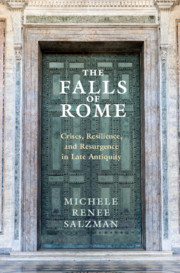75 results
The power of place: aristocrats in Late Antique Rome - C. Machado 2019. Urban Space and Aristocratic Power in Late Antique Rome: AD 270–535. Oxford: Oxford University Press. Pp. xi + 317, with 25 black-and-white figs. ISBN 978-0-19-883507-3.
-
- Journal:
- Journal of Roman Archaeology / Volume 34 / Issue 2 / December 2021
- Published online by Cambridge University Press:
- 16 November 2021, pp. 972-974
- Print publication:
- December 2021
-
- Article
- Export citation
5 - Why Gibbon Was Wrong
-
- Book:
- The Falls of Rome
- Published online:
- 04 September 2021
- Print publication:
- 09 September 2021, pp 197-242
-
- Chapter
- Export citation
Abbreviations for Imperial Offices in Late Antiquity
-
- Book:
- The Falls of Rome
- Published online:
- 04 September 2021
- Print publication:
- 09 September 2021, pp xiv-xviii
-
- Chapter
- Export citation
Bibliography
-
- Book:
- The Falls of Rome
- Published online:
- 04 September 2021
- Print publication:
- 09 September 2021, pp 400-430
-
- Chapter
- Export citation
Abbreviations for Frequently Cited Works
-
- Book:
- The Falls of Rome
- Published online:
- 04 September 2021
- Print publication:
- 09 September 2021, pp xi-xiii
-
- Chapter
- Export citation
7 - The Demise of the Senate
-
- Book:
- The Falls of Rome
- Published online:
- 04 September 2021
- Print publication:
- 09 September 2021, pp 300-336
-
- Chapter
- Export citation
1 - Approaches to the Fate of the Late Antique City
-
- Book:
- The Falls of Rome
- Published online:
- 04 September 2021
- Print publication:
- 09 September 2021, pp 1-35
-
- Chapter
- Export citation
6 - The Fall of Ostrogothic Rome and the Justinianic Reconstruction
-
- Book:
- The Falls of Rome
- Published online:
- 04 September 2021
- Print publication:
- 09 September 2021, pp 243-299
-
- Chapter
- Export citation
Contents
-
- Book:
- The Falls of Rome
- Published online:
- 04 September 2021
- Print publication:
- 09 September 2021, pp v-v
-
- Chapter
- Export citation
2 - The Constantinian Compromise
-
- Book:
- The Falls of Rome
- Published online:
- 04 September 2021
- Print publication:
- 09 September 2021, pp 36-95
-
- Chapter
- Export citation
Index
-
- Book:
- The Falls of Rome
- Published online:
- 04 September 2021
- Print publication:
- 09 September 2021, pp 431-446
-
- Chapter
- Export citation
Maps
-
- Book:
- The Falls of Rome
- Published online:
- 04 September 2021
- Print publication:
- 09 September 2021, pp vi-vi
-
- Chapter
- Export citation
4 - Rome after the 455 Vandal Occupation
-
- Book:
- The Falls of Rome
- Published online:
- 04 September 2021
- Print publication:
- 09 September 2021, pp 148-196
-
- Chapter
- Export citation
Copyright page
-
- Book:
- The Falls of Rome
- Published online:
- 04 September 2021
- Print publication:
- 09 September 2021, pp iv-iv
-
- Chapter
- Export citation
Acknowledgments
-
- Book:
- The Falls of Rome
- Published online:
- 04 September 2021
- Print publication:
- 09 September 2021, pp viii-x
-
- Chapter
- Export citation
Tables
-
- Book:
- The Falls of Rome
- Published online:
- 04 September 2021
- Print publication:
- 09 September 2021, pp 337-399
-
- Chapter
- Export citation
3 - Responses to the Sack of Rome in 410
-
- Book:
- The Falls of Rome
- Published online:
- 04 September 2021
- Print publication:
- 09 September 2021, pp 96-147
-
- Chapter
- Export citation
Figures
-
- Book:
- The Falls of Rome
- Published online:
- 04 September 2021
- Print publication:
- 09 September 2021, pp vii-vii
-
- Chapter
- Export citation

The Falls of Rome
- Crises, Resilience, and Resurgence in Late Antiquity
-
- Published online:
- 04 September 2021
- Print publication:
- 09 September 2021
Chromatius of Aquileia and the Making of a Christian City. By Robert McEachnie. New York: Routledge, 2017. ix + 194 pp. $155.00 cloth.
-
- Journal:
- Church History / Volume 88 / Issue 3 / September 2019
- Published online by Cambridge University Press:
- 16 October 2019, pp. 796-798
- Print publication:
- September 2019
-
- Article
- Export citation



